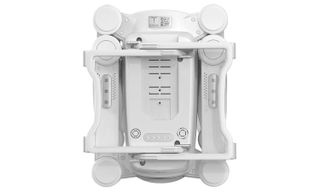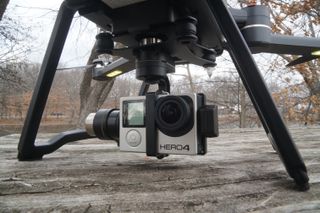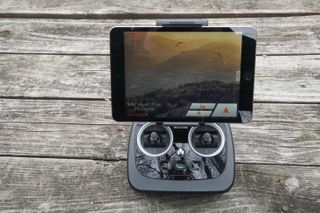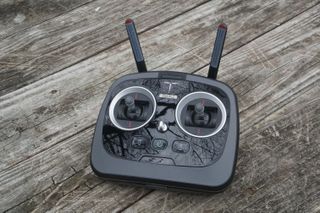GDU Byrd Advanced Drone Review: Flexible Flier
The GDU Byrd lets you attach a variety of cameras to its frame, but it doesn’t offer as much control or as many features as the DJI Mavic Pro.
Why you can trust Tom's Guide

The DJI Mavic Pro set the cat amongst the drone pigeons, showing that a compact drone doesn’t have to have a compact feature list. The GDU Byrd Advanced 1.0 is the latest of these compact drones, with deftly designed, fold-out arms and landing gear that make it compact when stored, but larger in flight. Although it’s not as compact as the DJI Mavic Pro, the GDU is more versatile, letting you swap out different cameras, and it has a lower starting price of $749 — but you’ll need to bring your own GoPro.
Design: Larger Than the Mavic Pro
The Byrd Advanced is a bit of a wolf in sheep's clothing: It’s fairly small when folded up, but it expands into a large drone. In its folded state, the Byrd measures 10.7 x 8.8 x 4.21 inches. That’s much larger than the folded-up Mavic Pro (8 x 4 x 3.5 inches), and that size for the Byrd doesn’t include the gimbal or camera. It’s still quite portable, though, and will fit easily into a small backpack.
The arms of the drone fold out horizontally, with the blades folding flat against them in storage. The landing gear is made of two U-shaped plastic pieces that fold flat against the body. When it’s ready to fly, the Byrd measures a large 31 x 26 inches (from rotor tip to rotor tip) and 9.5 inches high. That makes it a big quadcopter — larger than the Phantom 4 and most similar models. It’s fairly light for the size, though; we measured the takeoff weight (including the battery and a GoPro Hero4) at 4.9 pounds.

On the base of the Byrd’s body is a sonar sensor and a camera, both of which are used to detect the ground below. However, there are no forward-facing cameras or other obstacle-detecting sensors, such as the cameras on the Phantom 4 that try to prevent it from flying into a tree.
MORE: The Best Drones and Quadcopters on Any Budget
Interchangeable Gimbal, But Bring Your Own Camera
One of the Byrd’s interesting features is its interchangeable gimbal. Whereas the Mavic and many other drones are restricted to the built-in camera and gimbal, the Byrd lets you remove the entire gimbal assembly and replace it with one that holds a different camera. The model I tested supports a GoPro Hero4 or Hero5 camera, which can pan and tilt on command.

The gimbal comes with a small cushioned pack, but there’s nothing to hold the drone itself. The GDU Byrd Advanced model I tested costs $849 but doesn’t include a GoPro camera, which you’ll need to purchase separately.
Professional users might be interested in the other gimbal options GDU offers: The ILDC gimbal ($169), which will be able to hold cameras weighing up to 28 ounces, such as the Sony RX100 Mk IV, the Sony a6000 or the Blackmagic Micro Studio video camera; a $999 gimbal that has a 4K camera with a 16-megapixel sensor and 10x zoom; an infrared camera gimbal; and the one-button stretching gimbal ($419), which lets you lower the camera below the GDU’s landing struts to get a clear 360-degree image.
GDU is even working on a prototype that allows you to carry a small weight (up to 1 pound) and release it from the drone in flight. Is the era of water-bombing drones upon us?
A Strong Flier
The process of getting the GDU Byrd flying is a bit more involved than it is for the Mavic Pro; there is more unfolding and attaching required. Once the drone is ready to fly, you start up the app, and it connects to the drone and tests out the various components. If parts such as the GPS compass and gyro check out, the drone is ready to go.

The Byrd is a fast, maneuverable drone that has plenty of power. It copes well with even fairly strong winds: The day I shot the sample video below, the winds reached about 10 mph, but the drone managed to hold its position at an altitude of 50 meters or so without issue. In this video, you can see how hard the drone has to work; the rotors are moving a lot as the drone jostles to keep in position against the gusting wind.
When you are done flying the drone, you press the Return to Home (RTH) button, and the drone returns to the takeoff point using GPS, hovers about 15 feet above the ground and slowly descends to a gentle landing.
Video and Photo Quality
The GDU Byrd’s video and image quality depends on the camera you use. The GoPro Hero4 I used captured excellent video, but it wasn’t problem-free. For one thing, the camera picked up some vibrations from the drone body, resulting in slightly bouncy video when the drone was trying to combat gusty winds.
This model has a gimbal that can pan and tilt the camera, but the only thing isolating it from the vibrating body is a series of rubber joints that absorb the vibration. These don’t absorb all of the vibration, and the camera picks this up sometimes, especially when the drone is maneuvering. Also, the GoPro Hero4 sometimes caught sight of the drone’s rotor blades. You can mitigate this issue by switching to a narrower point of view on the camera (or adding an external lens, but the proximity of the camera to the rotors means that you still see them sometimes).
However, the biggest problem with this setup was that the app and controller were unable to control the GoPro camera. You get an excellent, high-quality preview of the image, but you can’t stop or start the camera recording or tweak the settings. All you get when you hit the record button is an error saying “Controls on this camera are not supported.” Therefore, you have to start the camera recording on the ground and hope the camera’s automatic settings can cope. GDU said this happens because of the licensing requirements required to control a GoPro camera. Either way, it is a problem that makes the Byrd less flexible than other drones.
GDU says the larger gimbal that can hold a Sony camera can control some features of the camera, such as turning the camera on and off, triggering the video and still-image shutter, and operating a zoom if present.
MORE: Why Drone Racing is the Next Big Sport
Effective Controller, Buggy App
The Byrd’s controller is a simple-looking, black-plastic device, about the size of a small bag of flour. It has a lot of inputs on its surface: eight buttons, two dials, one three-way switch and two control sticks. It fits well into your hands, though, with the control sticks falling under the thumb and the shoulder buttons and dials under the index fingers.

A phone/tablet holder clips into the top of the controller. However, this means you can’t really see the buttons on the controller when it is installed, so you’ll have to navigate them by touch. This is easy to learn, though, as they are all contoured or textured and easy to find.
You can adjust the holder to hold anything from a small phone to a medium-size tablet. I was able to use it with devices such as the Nexus 5 Android phone and an iPad mini in landscape mode. A standard iPad won’t fit in this, though, nor will the iPad mini in portrait mode.
These devices can run the GDU Pro app, which is available for Android and iOS. The app offers the full gamut of features you would expect, including a preview of the video from the camera and overlaid controls for the camera and other features.

There are no on-screen control sticks, though; you will always need to use this app alongside the controller. With the model I tested, the preview video was from the GoPro Hero4 that this gimbal supports, but you get the same type of preview from the other types of gimbals.
I found GDU’s app somewhat buggy; it failed to start on one device (a Nexus 5X running Android 7.1) until I removed the program, rebooted and reinstalled it. The app also crashed occasionally on an iPad mini when it started. It didn’t crash while the drone was in flight, but it has some rough spots. If, for instance, you hit the Auto-Takeoff button without initializing the drone from the controller, the drone won’t take off, but the app won’t produce any error messages or any other indications of what the problem is, either. Similarly, when you try to control the GoPro camera from the app, it produces the unhelpful message “Feature not enabled on this camera.”
Limited Autonomous Flying
The Byrd app includes a simple, maps-based autonomous flight mode. When you tap the screen to create map points, the app calculates a flight path between them. You don’t get the fancy features of other drone map modes; for example, you can’t control the direction as it moves between points, smooth the path or generally tweak the path to get the video shot you want.
Nor do you get the other modes that drones such as the DJI Mavic Pro and the Phantom 4 offer. For example, you can’t automatically orbit the controller or a GPS point, you can’t move along a GPS-defined cable and you can’t track objects using the camera. The GDU Byrd offers only the basics of autonomous flight.
MORE: What the FAA's Drone Rules Could Mean for You
Repairability: Easy, to a Point
It’s easy to replace the GDU Byrd’s rotor blades: You just unscrew the top of the motor housing, lift and turn the retaining clip, and remove the individual blade. Each of the blades can be replaced individually. However, the rotor blades are the only parts of the drone that are easily replaced;other parts require more involved processes of removing the numerous small screws that hold the drone together. The details and pricing of the spare rotor blades are not currently available.
Battery Life
The battery that powers the Byrd is a hefty 6,700-mAh lithium-polymer brick that fits under a cover on the center of the drone’s body. We found that it powered the drone for about 25 minutes of flight time. That’s a little shorter than the 30 minutes that the company claims, but our flights do involve a lot of hard maneuvering, which uses more battery power.

The battery has to be removed from the drone to be charged and plugged into the included controller, which takes about an hour. The same charger recharges the controller battery, but it can charge only one drone battery at a time. Spare batteries cost $159.
Bottom Line
The GRU Byrd Advanced 1.0 drone has a lot of promise. It flies well, folds down into a relatively small package and can be outfitted with a variety of cameras. But there are rough edges that make the overall package less attractive. For example, you can’t control a GoPro camera, and the app is a little buggy.
If you just want to enjoy flying and take some videos, the DJI Mavic Pro is a better pick; it is much smaller, more portable and easier to fly. But the Mavic restricts you to the built-in camera, whereas the GDU Byrd offers the option of using a better camera, such as a Sony mirrorless camera. That might make it a more attractive option for serious or pro shooters.
Sign up to get the BEST of Tom’s Guide direct to your inbox.
Upgrade your life with a daily dose of the biggest tech news, lifestyle hacks and our curated analysis. Be the first to know about cutting-edge gadgets and the hottest deals.

Michael A. Prospero is the U.S. Editor-in-Chief for Tom’s Guide. He oversees all evergreen content and oversees the Homes, Smart Home, and Fitness/Wearables categories for the site. In his spare time, he also tests out the latest drones, electric scooters, and smart home gadgets, such as video doorbells. Before his tenure at Tom's Guide, he was the Reviews Editor for Laptop Magazine, a reporter at Fast Company, the Times of Trenton, and, many eons back, an intern at George magazine. He received his undergraduate degree from Boston College, where he worked on the campus newspaper The Heights, and then attended the Columbia University school of Journalism. When he’s not testing out the latest running watch, electric scooter, or skiing or training for a marathon, he’s probably using the latest sous vide machine, smoker, or pizza oven, to the delight — or chagrin — of his family.
